人教版(2019)必修 第二册Unit 1 Cultural Heritage Listening and Speaking 公开课课件(共25张PPT)
文档属性
| 名称 | 人教版(2019)必修 第二册Unit 1 Cultural Heritage Listening and Speaking 公开课课件(共25张PPT) | 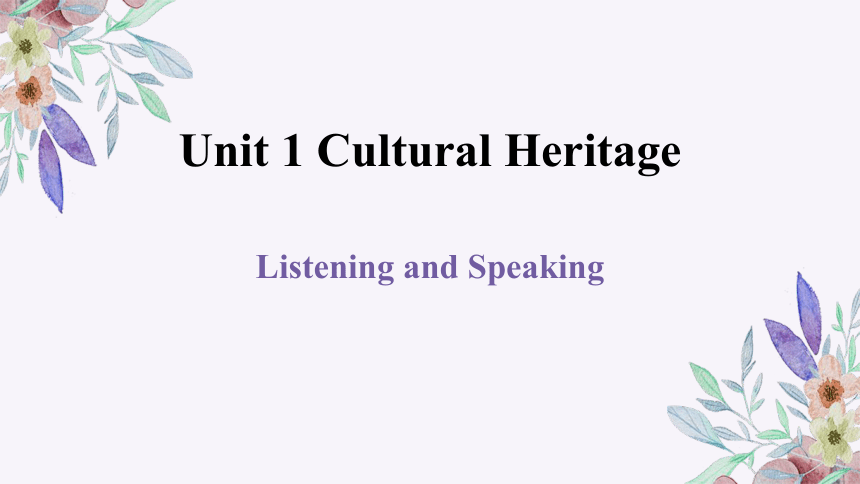 | |
| 格式 | pptx | ||
| 文件大小 | 6.7MB | ||
| 资源类型 | 教案 | ||
| 版本资源 | 人教版(2019) | ||
| 科目 | 英语 | ||
| 更新时间 | 2024-03-10 20:56:35 | ||
图片预览

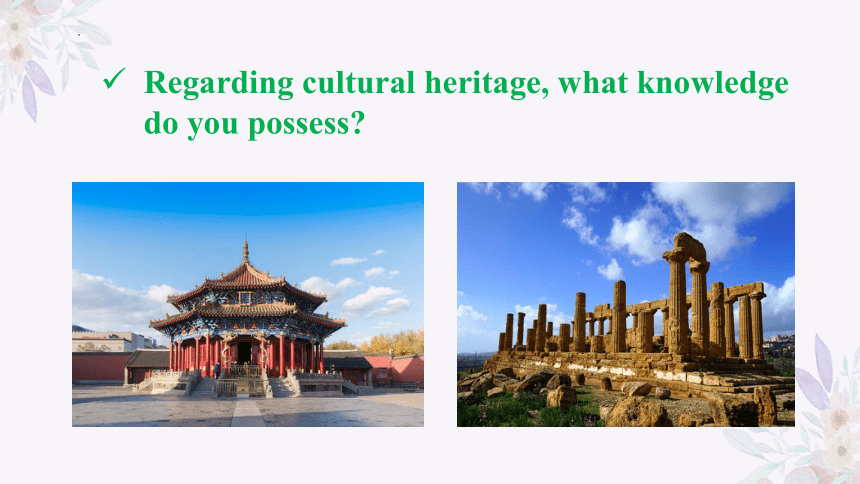
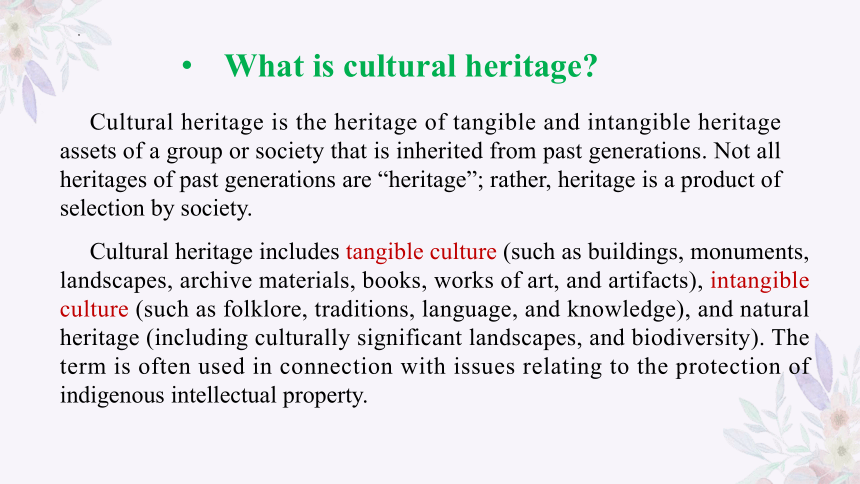
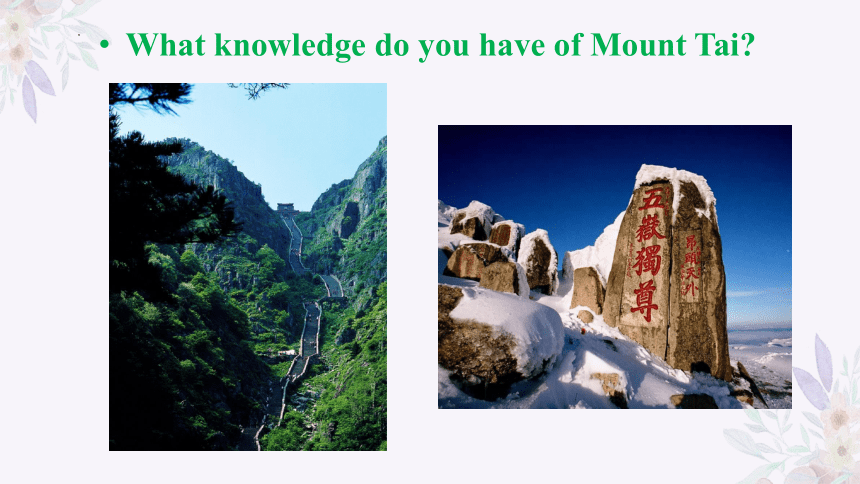
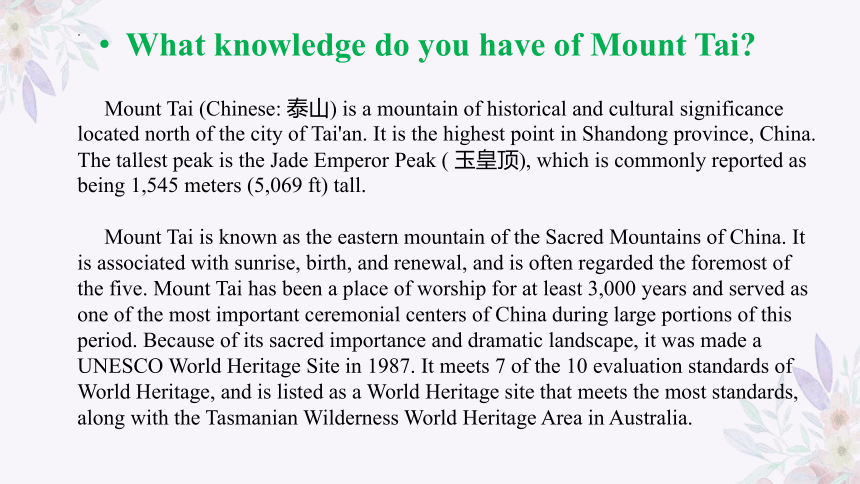
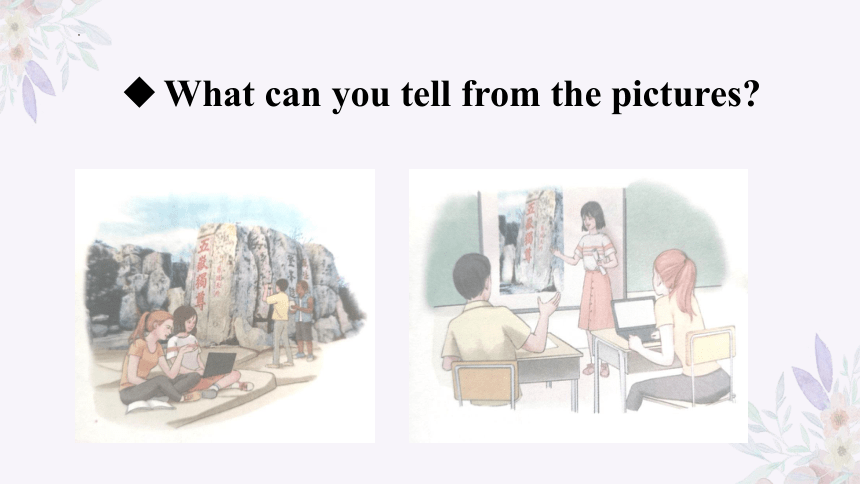
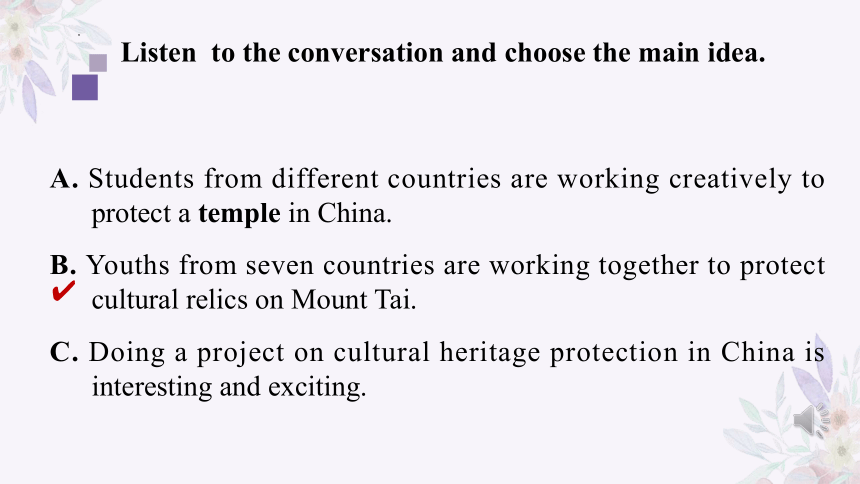
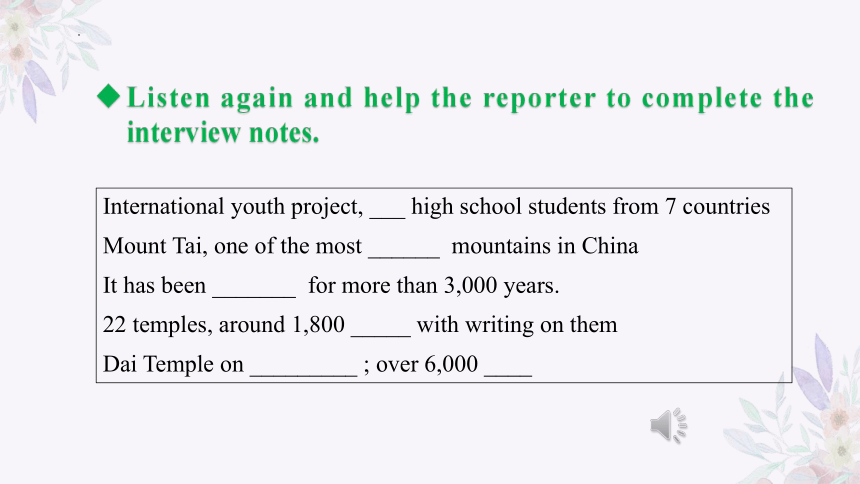
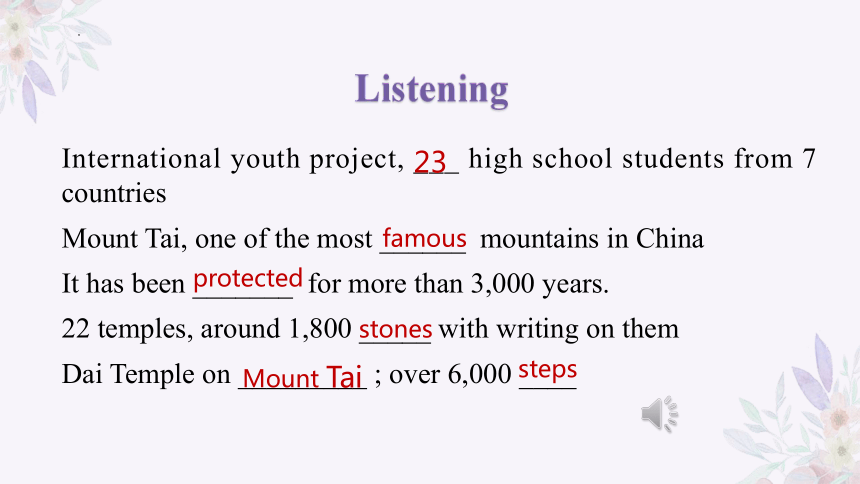
文档简介
(共25张PPT)
Unit 1 Cultural Heritage
Listening and Speaking
Regarding cultural heritage, what knowledge do you possess
Cultural heritage is the heritage of tangible and intangible heritage assets of a group or society that is inherited from past generations. Not all heritages of past generations are “heritage”; rather, heritage is a product of selection by society.
Cultural heritage includes tangible culture (such as buildings, monuments, landscapes, archive materials, books, works of art, and artifacts), intangible culture (such as folklore, traditions, language, and knowledge), and natural heritage (including culturally significant landscapes, and biodiversity). The term is often used in connection with issues relating to the protection of indigenous intellectual property.
What is cultural heritage
What knowledge do you have of Mount Tai
What knowledge do you have of Mount Tai
Mount Tai (Chinese: 泰山) is a mountain of historical and cultural significance located north of the city of Tai'an. It is the highest point in Shandong province, China. The tallest peak is the Jade Emperor Peak ( 玉皇顶), which is commonly reported as being 1,545 meters (5,069 ft) tall.
Mount Tai is known as the eastern mountain of the Sacred Mountains of China. It is associated with sunrise, birth, and renewal, and is often regarded the foremost of the five. Mount Tai has been a place of worship for at least 3,000 years and served as one of the most important ceremonial centers of China during large portions of this period. Because of its sacred importance and dramatic landscape, it was made a UNESCO World Heritage Site in 1987. It meets 7 of the 10 evaluation standards of World Heritage, and is listed as a World Heritage site that meets the most standards, along with the Tasmanian Wilderness World Heritage Area in Australia.
What can you tell from the pictures
A. Students from different countries are working creatively to protect a temple in China.
B. Youths from seven countries are working together to protect cultural relics on Mount Tai.
C. Doing a project on cultural heritage protection in China is interesting and exciting.
Listen to the conversation and choose the main idea.
Listen again and help the reporter to complete the interview notes.
International youth project, ___ high school students from 7 countries
Mount Tai, one of the most ______ mountains in China
It has been _______ for more than 3,000 years.
22 temples, around 1,800 _____ with writing on them
Dai Temple on _________ ; over 6,000 ____
International youth project, ___ high school students from 7 countries
Mount Tai, one of the most ______ mountains in China
It has been _______ for more than 3,000 years.
22 temples, around 1,800 _____ with writing on them
Dai Temple on _________ ; over 6,000 ____
Listening
23
famous
protected
stones
Mount Tai
steps
Guess the meaning of new words.
EXAMPLE
The palace was destroyed years ago. By studying old photos of the former palace, they have made the new one look exactly like the old one.
Guess: The former palace means “the palace that
____________________________”.
was built before but was destroyed
Listen to the conversation again and use the context to guess the meaning of the three words. Tick the reason why you were able to guess the words.
Complete the news report.
International Youth Camp Members Create Mount Tai App
Tai’an, 18 June 2019. A group of high school students who are taking part in an international youth camp at Mount Tai are creating a(n) ___ about China’s most famous mountain. The purpose of the camp is to _______ Mount Tai by introducing it to young people in a fun and easy way.
app
promote
Complete the news report.
The students are making an app about Mount Tai and taking photos of the ______ and stones. The volunteers also visit middle schools in the area in order to talk to local teenagers. Liu Bin, a member of the camp, says that he is _____ to help Mount Tai as people have done for more than 3,000 years.
temples
proud
What is usually in a title of a news report
What is the lead sentence of the news report
What is included in the lead
3. What is the structure of the news report
Brainstorming
Titles of news reports usually include key information about the subject matter in a concise and attention-grabbing format, often consisting of a headline, key information, location or time frame, action verbs, impact or consequence, emotive language (if applicable), clarity and accuracy, and a brief length.
What is usually in a title of a news report
sample
What is the lead sentence of the news report
The lead sentence of a news report, also known as the lead or lede, is the opening sentence or paragraph that summarizes the most important and relevant information of the story. It aims to grab the reader’s attention and provide a concise overview of the key points covered in the article.
sample
In the lead of a news report, several key elements are typically included:
1. Who: The lead often identifies the central figures or groups involved in the story, such as individuals, organizations, or communities.
2. What: It provides a brief summary of the main event, issue, or development being reported on.
3. When: The lead may include the time frame or date when the event occurred or when the news report is relevant.
4. Where: It specifies the location where the event took place or where the story is unfolding.
5. Why: The lead may offer insight into the significance or context of the news event, explaining why it's newsworthy or important to the audience.
6. How: Depending on the nature of the story, the lead may briefly mention how the event unfolded or how it's impacting relevant parties.
sample
The structure of a news report typically consists of a headline, byline, lead (lede), body, quotes, facts and figures, conclusion, attribution, dateline, and possibly additional elements such as subheadings or captions.
What is the structure of a news report
sample
Are you interested in working on a project similar to this one Why or why not
Could you come up with further strategies to safeguard cultural heritage
Speaking Practice
an example answer to Are you interested in working on a project similar to this one Why or why not :
“Yes, I am very interested in working on a project focused on the protection of cultural heritage. Cultural heritage represents the collective identity of humanity, reflecting our history, traditions, and values. Preserving it is not just about safeguarding monuments or artifacts; it’s about safeguarding our shared identity and understanding of the world.
Personally, I’ve always been fascinated by different cultures and their histories. Traveling to various countries and experiencing their rich cultural heritage firsthand has deeply impacted me. I've seen how cultural sites serve as living testimonies to the ingenuity and creativity of past civilizations, and I believe it’s our responsibility to protect and cherish these treasures for future generations.
Moreover, I am deeply committed to the idea that protecting cultural heritage is not just about preserving the past but also about building bridges between different communities and fostering mutual respect and understanding. By working on this project, I hope to contribute to the larger goal of promoting cultural diversity and heritage conservation on a global scale.
I am excited about the opportunity to collaborate with like-minded individuals who share a passion for cultural preservation. Together, I believe we can make a meaningful impact and ensure that our cultural heritage remains vibrant and accessible to all.”
“To safeguard cultural heritage, we can employ various strategies. Education and awareness campaigns play a crucial role in instilling the value of cultural heritage in communities. Leveraging technology like 3D scanning and digital archives aids in documentation and preservation efforts. Strengthening legislation and policies protects sites from harm, while community involvement fosters a sense of ownership and responsibility. International collaboration facilitates sharing resources and expertise, ensuring a coordinated global effort. Promoting sustainable tourism helps balance preservation with economic benefits. Additionally, developing emergency preparedness plans safeguards heritage from natural disasters and armed conflict. By implementing these multifaceted strategies, we can preserve our rich cultural legacy for future generations.”
Could you come up with further strategies to safeguard cultural heritage
Assignment
Review what you have learned in this class.
Write an essay on the protection of the cultural heritage.
Cultural heritage embodies the essence of human civilization, preserving our history, traditions, and values. Yet, it faces myriad threats in today's fast-paced world. Urbanization, climate change, armed conflict, and illicit trafficking endanger our cultural treasures. Protecting cultural heritage is imperative, as it maintains our collective identity and fosters social cohesion.
To address these challenges, comprehensive strategies are essential. Legislative measures must be strengthened to safeguard heritage sites, while stricter penalties for vandalism and trafficking should be enforced. International collaboration is crucial, facilitating the exchange of expertise and resources for heritage preservation.
Furthermore, leveraging technology such as 3D scanning and digital mapping enhances documentation and conservation munity involvement empowers local stakeholders as guardians of their heritage, ensuring sustainable management and inclusive development.
In conclusion, safeguarding cultural heritage is not only a moral obligation but also a means to preserve our shared heritage for future generations. Through concerted efforts encompassing legislation, technology, community engagement, and international cooperation, we can protect our cultural treasures and pass on our rich legacy to posterity.
sample writing 1:
sample writing 2:
Cultural heritage stands as a testament to the richness of human history and diversity. However, it confronts a myriad of challenges in our rapidly changing world. Urbanization, climate change, and conflict pose significant threats to our shared heritage, underscoring the urgent need for concerted action.
Safeguarding cultural heritage demands a multifaceted approach. Strengthening legal frameworks to protect heritage sites and imposing stricter penalties for violations is paramount. International collaboration plays a pivotal role, fostering knowledge exchange and collective efforts toward preservation.
Moreover, harnessing technological advancements, such as digitization and remote sensing, enhances conservation practices. Engaging local communities empowers them as custodians of their heritage, fostering a sense of ownership and sustainability.
In essence, the preservation of cultural heritage is not merely a matter of safeguarding artifacts; it is about preserving the soul of humanity. By embracing collaborative strategies that blend legal, technological, and community-driven approaches, we can ensure that our cultural tapestry remains intact for future generations to cherish and learn from.
See you!
Unit 1 Cultural Heritage
Listening and Speaking
Regarding cultural heritage, what knowledge do you possess
Cultural heritage is the heritage of tangible and intangible heritage assets of a group or society that is inherited from past generations. Not all heritages of past generations are “heritage”; rather, heritage is a product of selection by society.
Cultural heritage includes tangible culture (such as buildings, monuments, landscapes, archive materials, books, works of art, and artifacts), intangible culture (such as folklore, traditions, language, and knowledge), and natural heritage (including culturally significant landscapes, and biodiversity). The term is often used in connection with issues relating to the protection of indigenous intellectual property.
What is cultural heritage
What knowledge do you have of Mount Tai
What knowledge do you have of Mount Tai
Mount Tai (Chinese: 泰山) is a mountain of historical and cultural significance located north of the city of Tai'an. It is the highest point in Shandong province, China. The tallest peak is the Jade Emperor Peak ( 玉皇顶), which is commonly reported as being 1,545 meters (5,069 ft) tall.
Mount Tai is known as the eastern mountain of the Sacred Mountains of China. It is associated with sunrise, birth, and renewal, and is often regarded the foremost of the five. Mount Tai has been a place of worship for at least 3,000 years and served as one of the most important ceremonial centers of China during large portions of this period. Because of its sacred importance and dramatic landscape, it was made a UNESCO World Heritage Site in 1987. It meets 7 of the 10 evaluation standards of World Heritage, and is listed as a World Heritage site that meets the most standards, along with the Tasmanian Wilderness World Heritage Area in Australia.
What can you tell from the pictures
A. Students from different countries are working creatively to protect a temple in China.
B. Youths from seven countries are working together to protect cultural relics on Mount Tai.
C. Doing a project on cultural heritage protection in China is interesting and exciting.
Listen to the conversation and choose the main idea.
Listen again and help the reporter to complete the interview notes.
International youth project, ___ high school students from 7 countries
Mount Tai, one of the most ______ mountains in China
It has been _______ for more than 3,000 years.
22 temples, around 1,800 _____ with writing on them
Dai Temple on _________ ; over 6,000 ____
International youth project, ___ high school students from 7 countries
Mount Tai, one of the most ______ mountains in China
It has been _______ for more than 3,000 years.
22 temples, around 1,800 _____ with writing on them
Dai Temple on _________ ; over 6,000 ____
Listening
23
famous
protected
stones
Mount Tai
steps
Guess the meaning of new words.
EXAMPLE
The palace was destroyed years ago. By studying old photos of the former palace, they have made the new one look exactly like the old one.
Guess: The former palace means “the palace that
____________________________”.
was built before but was destroyed
Listen to the conversation again and use the context to guess the meaning of the three words. Tick the reason why you were able to guess the words.
Complete the news report.
International Youth Camp Members Create Mount Tai App
Tai’an, 18 June 2019. A group of high school students who are taking part in an international youth camp at Mount Tai are creating a(n) ___ about China’s most famous mountain. The purpose of the camp is to _______ Mount Tai by introducing it to young people in a fun and easy way.
app
promote
Complete the news report.
The students are making an app about Mount Tai and taking photos of the ______ and stones. The volunteers also visit middle schools in the area in order to talk to local teenagers. Liu Bin, a member of the camp, says that he is _____ to help Mount Tai as people have done for more than 3,000 years.
temples
proud
What is usually in a title of a news report
What is the lead sentence of the news report
What is included in the lead
3. What is the structure of the news report
Brainstorming
Titles of news reports usually include key information about the subject matter in a concise and attention-grabbing format, often consisting of a headline, key information, location or time frame, action verbs, impact or consequence, emotive language (if applicable), clarity and accuracy, and a brief length.
What is usually in a title of a news report
sample
What is the lead sentence of the news report
The lead sentence of a news report, also known as the lead or lede, is the opening sentence or paragraph that summarizes the most important and relevant information of the story. It aims to grab the reader’s attention and provide a concise overview of the key points covered in the article.
sample
In the lead of a news report, several key elements are typically included:
1. Who: The lead often identifies the central figures or groups involved in the story, such as individuals, organizations, or communities.
2. What: It provides a brief summary of the main event, issue, or development being reported on.
3. When: The lead may include the time frame or date when the event occurred or when the news report is relevant.
4. Where: It specifies the location where the event took place or where the story is unfolding.
5. Why: The lead may offer insight into the significance or context of the news event, explaining why it's newsworthy or important to the audience.
6. How: Depending on the nature of the story, the lead may briefly mention how the event unfolded or how it's impacting relevant parties.
sample
The structure of a news report typically consists of a headline, byline, lead (lede), body, quotes, facts and figures, conclusion, attribution, dateline, and possibly additional elements such as subheadings or captions.
What is the structure of a news report
sample
Are you interested in working on a project similar to this one Why or why not
Could you come up with further strategies to safeguard cultural heritage
Speaking Practice
an example answer to Are you interested in working on a project similar to this one Why or why not :
“Yes, I am very interested in working on a project focused on the protection of cultural heritage. Cultural heritage represents the collective identity of humanity, reflecting our history, traditions, and values. Preserving it is not just about safeguarding monuments or artifacts; it’s about safeguarding our shared identity and understanding of the world.
Personally, I’ve always been fascinated by different cultures and their histories. Traveling to various countries and experiencing their rich cultural heritage firsthand has deeply impacted me. I've seen how cultural sites serve as living testimonies to the ingenuity and creativity of past civilizations, and I believe it’s our responsibility to protect and cherish these treasures for future generations.
Moreover, I am deeply committed to the idea that protecting cultural heritage is not just about preserving the past but also about building bridges between different communities and fostering mutual respect and understanding. By working on this project, I hope to contribute to the larger goal of promoting cultural diversity and heritage conservation on a global scale.
I am excited about the opportunity to collaborate with like-minded individuals who share a passion for cultural preservation. Together, I believe we can make a meaningful impact and ensure that our cultural heritage remains vibrant and accessible to all.”
“To safeguard cultural heritage, we can employ various strategies. Education and awareness campaigns play a crucial role in instilling the value of cultural heritage in communities. Leveraging technology like 3D scanning and digital archives aids in documentation and preservation efforts. Strengthening legislation and policies protects sites from harm, while community involvement fosters a sense of ownership and responsibility. International collaboration facilitates sharing resources and expertise, ensuring a coordinated global effort. Promoting sustainable tourism helps balance preservation with economic benefits. Additionally, developing emergency preparedness plans safeguards heritage from natural disasters and armed conflict. By implementing these multifaceted strategies, we can preserve our rich cultural legacy for future generations.”
Could you come up with further strategies to safeguard cultural heritage
Assignment
Review what you have learned in this class.
Write an essay on the protection of the cultural heritage.
Cultural heritage embodies the essence of human civilization, preserving our history, traditions, and values. Yet, it faces myriad threats in today's fast-paced world. Urbanization, climate change, armed conflict, and illicit trafficking endanger our cultural treasures. Protecting cultural heritage is imperative, as it maintains our collective identity and fosters social cohesion.
To address these challenges, comprehensive strategies are essential. Legislative measures must be strengthened to safeguard heritage sites, while stricter penalties for vandalism and trafficking should be enforced. International collaboration is crucial, facilitating the exchange of expertise and resources for heritage preservation.
Furthermore, leveraging technology such as 3D scanning and digital mapping enhances documentation and conservation munity involvement empowers local stakeholders as guardians of their heritage, ensuring sustainable management and inclusive development.
In conclusion, safeguarding cultural heritage is not only a moral obligation but also a means to preserve our shared heritage for future generations. Through concerted efforts encompassing legislation, technology, community engagement, and international cooperation, we can protect our cultural treasures and pass on our rich legacy to posterity.
sample writing 1:
sample writing 2:
Cultural heritage stands as a testament to the richness of human history and diversity. However, it confronts a myriad of challenges in our rapidly changing world. Urbanization, climate change, and conflict pose significant threats to our shared heritage, underscoring the urgent need for concerted action.
Safeguarding cultural heritage demands a multifaceted approach. Strengthening legal frameworks to protect heritage sites and imposing stricter penalties for violations is paramount. International collaboration plays a pivotal role, fostering knowledge exchange and collective efforts toward preservation.
Moreover, harnessing technological advancements, such as digitization and remote sensing, enhances conservation practices. Engaging local communities empowers them as custodians of their heritage, fostering a sense of ownership and sustainability.
In essence, the preservation of cultural heritage is not merely a matter of safeguarding artifacts; it is about preserving the soul of humanity. By embracing collaborative strategies that blend legal, technological, and community-driven approaches, we can ensure that our cultural tapestry remains intact for future generations to cherish and learn from.
See you!
